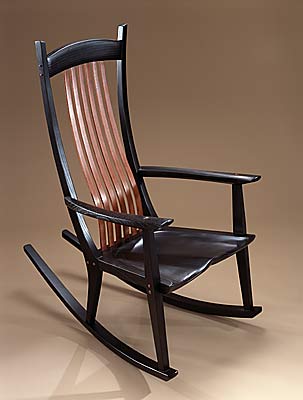흔들의자들입니다.
흔들의자 한번 만들어야 되는데.. ㅠ.ㅠ

Black Elemental Rocker
"Nothing is as luscious as good rich black," my 9th grade art teacher, Miss Souther, explained. And nothing shows off the ebonized oak or madrone in an Elemental Rocker as well as African bubinga backslats and pegs.
When Mike Richter, the New York Rangers' All-Star goalie, had back problems a couple of years ago, he flew to Los Angeles to see a specialist. He also started spending more time in his handcrafted rocking chair, made by Robert Erickson, a woodworker in Nevada City, California.
The Atlantic Monthly, April 2001


Chan rocker
This chair sits like the Floating Back Rocking Chair, but is shaped with subtly different contours in the headboard and arms. The interplay of soft, rounded shapes with crisp hard lines or arrises is borrowed from the sculpture of Isamu Noguchi and adapted to furniture by Sam Maloof.
California walnut

Another stylistic variation on the Floating Back Rocker
California walnut

Adjustable-Wood Seat
An innovation to the tradition of the rocker, this chair allows for adjustment of the angle of the back rest. Quarter sawn sycamore with rosewood slats

Adjustable Rocker-Upholstered
Common chairmaking wisdom goes something like this: When you increase the number of positions you can get out of a chair, you increase its overall comfort. The goal of comfortable seating is to support the sitter in a balanced or neutral position without curbing her ability to flex, stretch and relax certain muscles. Getting it right produces a chair that people can sit in comfortably for hours. The Adjustable Rocker adds a moveable back angle to its bag of tricks. This does two things. First, it allows the sitter to change positions, increasing comfortable sitting time. (La-Z-Boy™ recliners are famous for this.) Second, the adjustable back actually modifies the size of the chair, making it more versatile. Large people generally find the chair fits well when the back angle is more open, while smaller people seem to prefer the back adjusted to its closed position. The chair's curved seat nicely tucks the sitter into the back lumbar support. European elm and leather

Fiddleback Maple Floating Back
Hand shaped with hand tools, this rocker is the culmination of 30 years of experimentation and refinement.

Cherry Elemental
The Elemental Rocker is a distillation of more than 25 years of chairmaking experience. I designed it with the fair curves of wooden boat building, wanting to evoke the 1890s Henry Rushton canoes. My original concept in designing this chair was to make a rocker less expensive than, but equally comfortable as, the Floating Back Rocking Chair. To make this possible, I had to standardize the sizing and templates used for this chair. And I limit the woods I make the chair in to six classics in the woodworker's palette: walnut, cherry, oak, elm, ash and maple.
Cherry

Walnut Floating Back
I made my first rocking chair in 1974. Although it sported the organic curved shapes that evolved from the heyday of California's hippie crafts movement, it also incorporated a rudimentary floating back. That is, the flat slats of the back of the chair were not glued into place, but floated loose in grooves (mortices) routed into the chair's seat and headboard. Now, 29 years later, I'm still using the floating back in most of my chair designs, but I've spent years improving and refining the feature. With traditional bow-making techniques and triple laminations, I make resilient and flexible slats that conform to the human back. These slats support the person who sits in the chair with a comfortable, nearly massage-like springiness. Anyone who knows the American crafts movement will recognize the influence of the great furniture maker, Sam Maloof, in the lines of this rocker. Equally inspiring to me have been the mid-century Scandinavian designers, particularly the Danes, among them Hans Wegner. California black walnut



